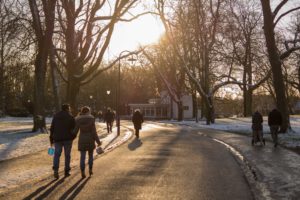Trees help your body heal. They boost your immune system, help you recover faster, and you’ll need fewer pain relievers. Continue reading “Trees for Healing”
Did you know?
Help your heart by planting trees
February is American Heart Month. Get heart healthy the easy way, head outside! Exposure to trees relaxes and restores your mind, lowering your blood pressure and heart rate. This helps to reduce incidences of cardiovascular and lower respiratory diseases. Conversely, tree loss from the spread of the emerald ash borer, and other insects and diseases, is associated with increased mortality related to cardiovascular and lower respiratory diseases.
Trees help achieve resolutions to be healthy
The sedentary lifestyle has become more common, and the shift has been costly. One result is an increase in obesity. Childhood obesity rates have tripled (12–19 years old) or quadrupled (6–11 years old,) and adult rates have doubled since the 1970s. Obesity increases risk of chronic diseases and conditions such as: high blood pressure, high cholesterol, diabetes, heart disease, stroke, gallbladder disease, osteoarthritis, sleep apnea, cancer and mental illness. This rise in chronic diseases related to obesity results in billions of dollars in medical costs and lost productivity each year. Continue reading “Trees help achieve resolutions to be healthy”
Another productive year for Wisconsin urban forestry!
Written by Jeff Roe, Urban Forestry Team Leader
As I reflect on this year, what stands out to me is cohesion and enthusiasm. Within the DNR, Division of Forestry, Urban Forestry Team and with our partners, I feel that communication, enthusiasm and follow-through have been hallmarks of this year.
Continue reading “Another productive year for Wisconsin urban forestry!”
Improve employee attitudes and well-being with exposure to trees and nature
The start of another weekday and we commute to work, only to be met by a dark cubicle or office covered in various shades of beige and grey. Ever wonder why your mood starts to match the walls? It’s because workplace environment contributes to employee health.
Continue reading “Improve employee attitudes and well-being with exposure to trees and nature”
Improve mental health with exposure to trees and nature
If stress about the upcoming holiday season is beginning to build, put on your coat and hat, get yourself outside and walk around under your neighborhood trees. Exposure to nature reduces depression, anxiety and stress! Time spent in nature provides a wealth of mental health benefits. Continue reading “Improve mental health with exposure to trees and nature”
Social media study explores how to connect homeowners with arborist
How do people respond differently to messages about caring for the trees in the yard? Which messages motivate homeowners to contact a certified arborist to help them care for their trees? This spring, the Wisconsin DNR partnered with the Wisconsin Arborist Association (WAA), University of Wisconsin-Madison and UW-Extension to design a Facebook outreach campaign to test these questions. A new resource with the results and social marketing insights from the study is now available.
Continue reading “Social media study explores how to connect homeowners with arborist”
Reduce crime and violence with trees in your neighborhood
Can trees reduce aggression, violence and crime? Multiple studies say, “Yes!” October is domestic violence awareness month. Let trees be part of the solution. Levels of aggression and violence have been shown to be significantly lower among individuals who have some nearby nature outside their apartments than among their counterparts who live in barren conditions. Surveys exploring these results show residents with green views report using reasoning more often in conflicts with their children rather than violence. They also report less use of physical violence in conflicts with partners compared to those living in buildings without trees. Continue reading “Reduce crime and violence with trees in your neighborhood”
Foster student success with trees in your neighborhood
September is back to school month. How do you get those kids to settle down and focus after three months off? The answer is as simple as walking right outside your front door! Exposure to nature has shown various impacts on students, from improved academic performance and focus, to reduced Attention Deficit Hyperactivity Disorder (ADHD) symptoms. Research has shown exposure to nature during school hours is positively associated with academic performance, including standardized test scores, graduation rates, and plans to attend a four-year college. Continue reading “Foster student success with trees in your neighborhood”
Getting active in Wisconsin’s urban forest
 By Rob Fontella, fontella@wisc.edu, healthTIDE UW-Madison Public Health
By Rob Fontella, fontella@wisc.edu, healthTIDE UW-Madison Public Health
As the weather gets warmer, Wisconsinites are getting out there and enjoying their community and the natural areas the state has to offer. Recently a new effort was launched to encourage communities in Wisconsin to become part of a campaign recognizing the community’s efforts to promote active lifestyles. Continue reading “Getting active in Wisconsin’s urban forest”

